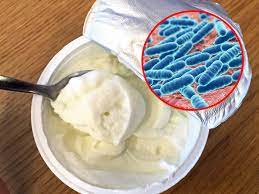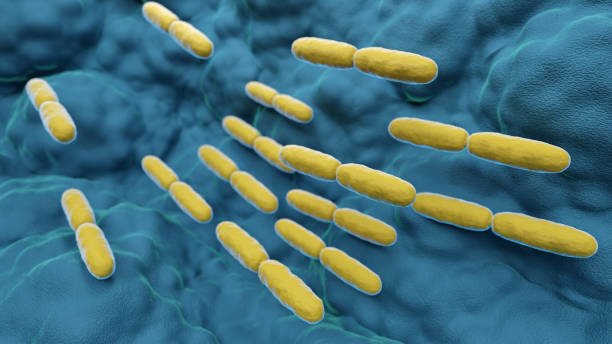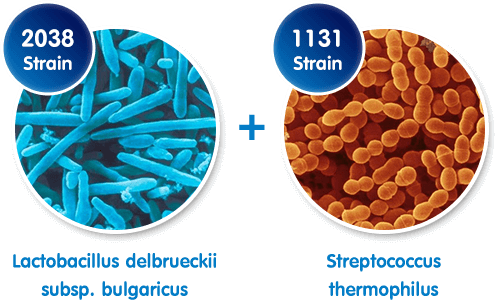Bacteria in CurdWhat is Yogurt?Yogurt is made by fermenting milk products containing the characteristics of bacterial cultures of Lactobacillus bulgaricus and Streptococcus thermophilus. A yogurt is a composition of 8.25% solids not fat. The full-fat curd must contain at least 3.25% milk fat whereas the low-fat curd contains at least 2% of milk fat and the non-fat curd must have 0.5% milk. The U.S. Code of Federal Regulation (CFR) has a list of standards that are specified as full fat yogurt, low fat yogurt, and non-fat yogurt. 
Bacteria found in YogurtThe main bacterium used to produce curd is Lactobacillus delbrueckii subsp. bulgaricus. Lactobacillus has a significant role in the ripening of some cheese and other processes which involves naturally fermented products. It is referred to as homo-fermentive lactic acid. lactic acid is the single end product of its carbohydrate digestion. It is also known as prebiotic. The lactobacillus is a gram-positive bacterium that appears long rod-like structure with filaments. It is a non-motile bacterium and does not produce spores. Moreover, it is also non-pathogenic and non-toxic. Characteristics of the Bacteria
Lactobacillus bacteria also come under the category of Acidophilliic or Aciduric bacteria as it needs low pH of 4.6-5.4 to grow effectively. Moreover, they are anaerobic bacteria. They tend to grow better on raw dairy products as it creates and maintains the acidic environment, which is required for the production of lactic acid by lactobacillus sp. They grow effectively in an optimum temperature of 40-44°C under anaerobic conditions. Lactobacillus sp. requires complex nutritional modes which may differ according to the environment. The nutritional media should require carbohydrates, unsaturated fatty acids, amino acids and vitamins. Where do the bacteria found?It was first identified in 1905 by Bulgarian doctor Stamen Grigorov by isolating a bacterium that got named Lactobacillus delbrueckii subsp. bulgaricus from yogurt sample. The bacteria can also be found in gastrointestinal tract of mammals in the Shopluk mesoregion of Balkan Peninsula. Lactobacillus bulgaricus strain GLB44 is isolated from the leaves of Galanthus nivalis (common name - Snowdrop flower) in Bulgaria region. The bacterium is also seen to grow synthetically in many countries. Yogurt is made by the two important bacteria Lactobacillus delbrueckii subsp. bulgaricus and Streptococcus thermophillus. These two bacteria are used as starters in the making of yogurt. In the fermentation of yogurt, the Lactobacillus bulgaricus strain 2038 has been used for several decades now. The two bacteria species work in synergy as the L. bulgaricus produce amino acids from milk proteins which are then utilized by S. thermophilus. They both maintain symbiotic relationship. Both bacterial species produce lactic acid which eventually ferments the milk into yogurt. The lactic acid provides the tart flavor and acts as a preservative in the yogurt. It also reduces the pH which partially coagulates the milk protein like casein which results in the extra thickness of yogurt. Lactobacillus bulgaricus produces acetaldehyde while fermenting the milk which gives a unique aroma to the yogurt. Some strains of L. bulgaricus like GLB44 strain is known to produce bacteriocins which kills the unwanted bacteria in the yogurt in vitro. The viability of Lactobacillus delbrueckii subsp. Bulgaricus is very crucial to the yogurt as it is very efficient for the fermentation process and effective to prevent food spoilage. The viability of these bacteria can be preserved by freeze-drying method however, it is not a full-proof method to make all the cells survive. So, lactobacillus bulgaricus has great economic importance as it plays an important role in the natural fermentation process, especially how it makes the fermented food products out of cow's milk. Japan, the United States and the European Union are some of the biggest importers of the bacteria Lactobacillus. Bulgaricus. The bacteria also show contamination in beer fermentation due to its homo-fermentive production of lactic acid which gives a pungent flavor to many beers. In other beverages, the bacteria with lactic acid can contribute to various properties like aroma, taste, and mouthfeel and generally produce gentle sourness to it. Experiment to observe bacteria present in Yogurt under microscopeMaterials Required - yogurt sample, glass slide, coverslips, blotting paper, cotton swabs and Methylene blue solution dye. ProtocolWithout applying stain
Note - The bacteria found in yogurt are not harmful and therefore safe to use.ProtocolWith stainingThe process of staining includes the use of heat and methylene blue stain.
Observation and ResultThe microscopic observation shows the presence of two bacteria in the curd which are Lactobacillus bulgaricus (rod shaped) Streptococcus thermophilus (spherical) 
Next TopicTransduction in Bacteria
|
 For Videos Join Our Youtube Channel: Join Now
For Videos Join Our Youtube Channel: Join Now
Feedback
- Send your Feedback to [email protected]
Help Others, Please Share









